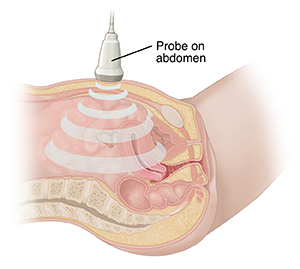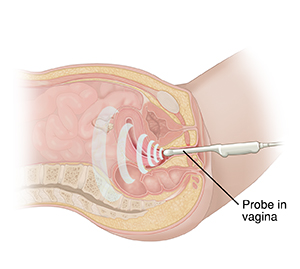Pelvic Ultrasound
Pelvic ultrasound is an imaging test that uses sound waves to form pictures of your organs. It can help assess pain or other symptoms within your pelvis, the area between your hip bones. In women who are not pregnant, it is typically done to check the uterus and ovaries. In pregnant women, it is used to check the health of the unborn baby. There are no known risks of diagnostic ultrasound.
How do I get ready for an ultrasound?
-
You may be told to drink several glasses of water or other clear fluid starting 1 to 2 hours before your test. Ask your healthcare provider for specific instructions.
-
The test may take 30 to 45 minutes. Allow extra time to check in.
Important
The healthcare professional doing the ultrasound may ask why your healthcare provider has ordered the test. They may also ask when your last period started. Also let them know:
What happens during the ultrasound?
-
You will lie on your back with your belly (abdomen) exposed.
-
A nongreasy gel will be applied to the skin.
-
The sonographer will move a handheld probe (transducer) across your pelvis.
The test may include a second part. You can empty your bladder before this part of the test.
-
You will lie on your back with your knees raised.
-
A probe covered with nongreasy gel is placed inside your vagina. Or you may be asked to insert the probe yourself as you would a tampon. The probe should not be painful.


Your healthcare provider will explain the results.
What happens after an ultrasound?
Online Medical Reviewer:
Donna Freeborn PhD CNM FNP
Online Medical Reviewer:
Heather M Trevino BSN RNC
Online Medical Reviewer:
Irina Burd MD PhD
Date Last Reviewed:
8/1/2022
© 2000-2025 The StayWell Company, LLC. All rights reserved. This information is not intended as a substitute for professional medical care. Always follow your healthcare professional's instructions.